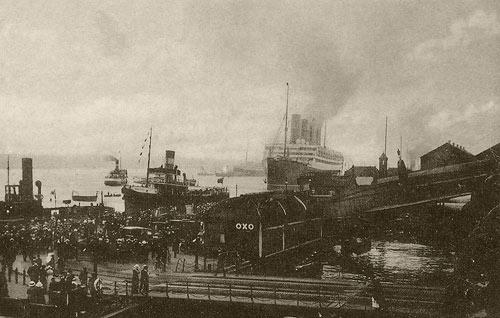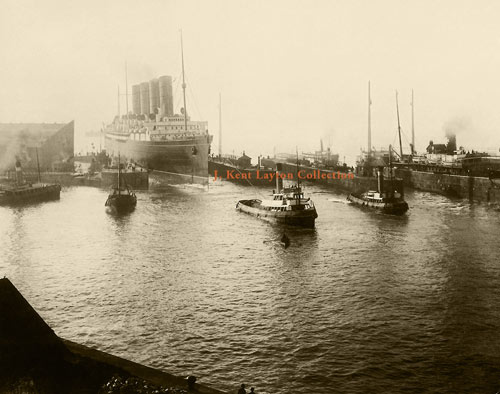Lusitania: 'If business demanded' it
This is the 7th blog post in a series by J Kent Layton, maritime historian and author of ‘Lusitania: an illustrated biography’, to accompany the exhibition Lusitania: life, loss, legacy at the Maritime Museum.

As the winter months began to wind down in early 1915, bookings were increasing on the North Atlantic again. Fears were beginning to subside, and with the threat of naval dangers at sea seeming more remote to prospective passengers, there was apparently less reason not to travel. As a result, Cunard began to see an increased need for passenger capacity. Indeed, on her 202nd crossing, headed east from New York on 1 May, the Lusitania's second class spaces were overbooked, and overall it was her longest east-bound passenger list since the war's outbreak.
As we all know, the idea of using ocean liners as armed merchant cruisers went by-the-board very early on in the war; this meant that instead of being chartered and used in Government service, the Lusitania remained in civilian service. It now also meant that the Mauretania was available for use as a passenger liner. On Wednesday 5 May Cunard made a public announcement that they would be returning the Mauretania to service on the Atlantic and that her first sailing from Liverpool would begin on 29 May, the same day that the Lusitania was next scheduled to sail east from New York. They were so optimistic that they even left open the option to return the Aquitania to passenger service 'if business demanded' her use in that manner.
The Aquitania, larger running mate of the Lusitania and Mauretania,
in a rare scene at the Liverpool Landing Stage just before the war.
© J Kent Layton Collection
This decision really demonstrated the high rate of confidence that Cunard felt about the safety of their ships on that Liverpool-New York route. It also shows that the Admiralty felt reasonably confident about the safety of those ships, an important point since both had been paid for under the 1902 Government loan, which had not yet been fully repaid, and they were ships that could be very useful to the Allied effort as troop transports or hospital ships in the future. Without the benefit of hindsight, the confidence may have seemed justified. People were still accustomed to 'gentlemanly' naval conflicts that were really holdovers from the Napoleonic days.
The submarine blockade declared on 4 February 1915 was not yet catching up with a high percentage of shipping traffic, and no ship traveling over 14-15 knots had yet fallen victim to a torpedo. Plus it is very likely that Cunard and Admiralty personnel thought it unlikely that German submariners would have the audacity to attack the mighty passenger liner Lusitania. Such an act would bring down a firestorm of negative public opinion on them that would make the fallout from the recent Belgian atrocities seem like a picnic. Yet there were warning signs. German submarines were beginning to shoot first and ask questions later, and in the days leading up to and during the Lusitania's 202nd crossing, a neutral American tanker and several moderately-sized British steamers were attacked, and some were sunk, by German subs. The real question began to surface: what would happen if a German submarine came across the Lusitania?
The Mauretania being manuevered around the Liverpool docks by tugboats.
© J Kent Layton Collection


